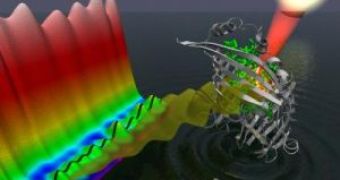This is the engine of life on Earth: photosynthesis is the process by which plants and cyanobacteria retain sunlight energy into biochemical compounds with almost 100-percent efficiency.
The energy transfer must occur almost instantaneously, so little energy amount is lost as heat, so the secret is in the speed of the reactions.
Now a research made by a mixed team from the U.S. Department of Energy's Lawrence Berkeley National Laboratory (Berkeley Lab) and the University of California (UC) at Berkeley has solved this puzzle employing quantum mechanical effects.
Artificial photosynthesis would help to employ sunlight as a clean, free, sustainable and carbon-neutral source of energy. "We have obtained the first direct evidence that remarkably long-lived wavelike electronic quantum coherence plays an important part in energy transfer processes during photosynthesis," said Graham Fleming, the main researcher and professor of chemistry at UC Berkeley. "This wavelike characteristic can explain the extreme efficiency of the energy transfer because it enables the system to simultaneously sample all the potential energy pathways and choose the most efficient one."
The team detected "quantum beating" signals, coherent electronic oscillations in both donor and acceptor molecules, induced by light energy excitations.
Two-dimensional electronic spectroscopy detected on a femtosecond (1/1000 000 000 000 000 of a second) time-scale these oscillations meeting and how they interfered, building wavelike motions of energy (superposition states) that can experience all possible energy pathways at a time and reversibly, so that they can go back from incorrect pathways with no penalty.
This spectroscopy employs sequentially flashing a sample with femtosecond pulses of light from three laser beams, while a fourth beam is employed to increase and detect the resulting spectroscopic signals as the excitation energy from the laser lights is transmitted from one molecule to the next. (This energy is modified by how each molecule absorbs and emits light.)
Classical theory describes the photosynthesis' energy transfer as excitation energy leaps from photo-pigments to reactive molecules from stage to stage in a molecular energy ladder. "The classical hopping description of the energy transfer process is both inadequate and inaccurate," said Fleming.
The 2-D electronic spectroscopy can detect the energy transfer between molecules that are grouped in photoactive systems, due to their similar electronic and vibrational states.
The team investigated the Fenna-Matthews-Olson (FMO) photosynthetic protein, a molecular complex in green sulphur bacteria. FMO is preferred in photosynthesis researches because of its simplicity: it is made of just seven pigment molecules. "To observe the quantum beats, 2-D spectra were taken at 33 population times, ranging from 0 to 660 femtoseconds," said Gregory Engel, the first author.
"In these spectra, the lowest-energy exciton (a bound electron-hole pair formed when an incoming photon boosts an electron out of the valence energy band into the conduction band) gives rise to a diagonal peak near 825 nanometers that clearly oscillates. The associated cross-peak amplitude also appears to oscillate. Surprisingly, this quantum beating lasted the entire 660 femtoseconds."
"The duration of the quantum beating signals was unexpected because the general scientific assumption had been that the electronic coherences responsible for such oscillations are rapidly destroyed. For this reason, the transfer of electronic coherence between excitons during relaxation has usually been ignored," Engel said. "By demonstrating that the energy transfer process does involve electronic coherence and that this coherence is much stronger than we would ever have expected, we have shown that the process can be much more efficient than the classical view could explain."
The team will investigate how temperature and light's wavelengths (color) influence the photosynthetic energy transfer process. The current results were achieved at 77 Kelvin (350 degree Celsius). "Nature has had about 2.7 billion years to perfect photosynthesis, so there are huge lessons that remain for us to learn. The results we're reporting in this latest paper, however, at least give us a new way to think about the design of future artificial photosynthesis systems", said Engels.

 14 DAY TRIAL //
14 DAY TRIAL //